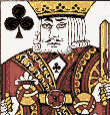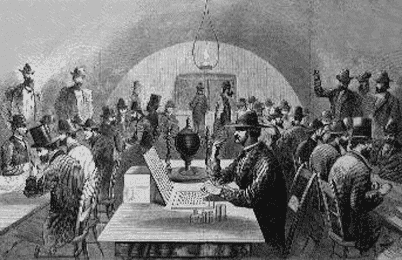 |
Progress Publishing Co. |
 |
|
Keno Rules and Odds |
 |
Progress Publishing Co. |
 |
|
Keno Rules and Odds |

![]()

![]()
Keno Rules and Odds
*******************************************************************
Keno Rules
Keno Odds
Keno House Percentage against a Player
*******************************************************************
Keno Rules
There are few simple rules that every player needs to know to eliminate bad surprises and make his keno gambling an enjoyable experience. Most of the rules relate to the maximum payoff, filling correctly the keno tickets, playing the tickets, replaying the previous tickets, collecting winnings and using the help of keno runners.
The maximum keno payoff, which in most casinos is $50,000, is an aggregate amount. That means that if the few players won the top prize, the $50,000 will be divided amongst them. The aggregate rule was imposed a long time ago on casino operators by Nevada Gaming Commission. The purpose of that law was to protect casino in case of the few top winners. Today, most of the casinos are owned by the corporations, which provide, in practical terms, an unlimited bankroll to support casino operations. The old “aggregate” law and the maximum cap of $50,000 lost the reasons for their existence. In result, in 1989 Nevada Gaming Commission removed the limits for the top prizes. Some casinos have now $100,000 and even $1,000,000 limits per game. On the other hand many casinos still maintain that old aggregate maximum of $50,000. If a player decides to raise his wager, he should be aware of the maximum win allowed by casino, because at some point an increase in wager might not produce the proportionate increase in winnings due the imposed limit for the top prize.
The keno games are conducted with the intervals of about 5 minutes. In a 24-hour period casino might have more than two hundred games. He has to mark the numbers on the ticket he wants to play by crossing or circling them with black crayons always available for the players. Keno rules do not permit using pens and pencils for marking the numbers. The necessary information that must be filled on the ticket includes chosen numbers, the size of the wager and the number of the played spots. The example below shows the correctly filled standard keno ticket.
|
100 |
|||||||||||
| 1 | 2 | 3 | 4 | 5 | 6 | 7 | 8 | 9 | 10 |
6 |
|
| 11 | 12 | 13 | 14 | 15 | 16 | 17 | 18 | 19 | 20 | ||
| 21 | 22 | 23 | 24 | 25 | 26 | 27 | 28 | 29 | 30 | ||
| 31 | 32 | 33 | 34 | 35 | 36 | 37 | 38 | 39 | 40 | ||
| Keno Limit $50,000 to aggregate players each game | |||||||||||
| 41 | 42 | 43 | 44 | 45 | 46 | 47 | 48 | 49 | 50 | ||
| 51 | 52 | 53 | 54 | 55 | 56 | 57 | 58 | 59 | 60 | ||
| 51 | 62 | 63 | 64 | 65 | 66 | 67 | 68 | 69 | 70 | ||
| 71 | 72 | 73 | 74 | 75 | 76 | 77 | 78 | 79 | 80 | ||
The chosen numbers were crossed, the wager was indicated on the top right corner and the number of the spots played was written on the right side of the ticket. A player takes his original filled by him ticket to the keno writer to place his bet and get a duplicate ticket as a proof of his bet. Keno rules require players to check the tickets for errors after they’ve been processed by the keno writer. In return for his original ticket, a player gets from a keno writer a duplicate printed by a computer. In most cases the tickets are paid according to the computer-issued outside tickets instead of the original (inside) tickets given to the keno writer. If the outside tickets have errors, which are not corrected before the game is played, then, by the keno rules, they become the official tickets for the game.
The big electronic flashboard in the middle of the keno lounge shows all the information about the current game. The twenty numbers randomly chosen from 80 are lit up when the keno draw (race) is completed. The number of the draw is displayed usually on the bottom of the board or sometimes on the side of it. When the sign “Closed” appears on the board and the illuminated winning numbers for the previous race disappear, that means that keno personnel is ready to start a next race. At that moment it is too late for the players to bet on the next draw and no additional bets will be accepted. The keno rules clearly state that the players should have their tickets ready and processed before the sign “Closed” appears on the board.
Some players have the favorite numbers they always like to play. Keno rules accommodate such players and allow them to use duplicate tickets as the new original tickets. Instead of writing a new ticket, which is an exact copy of the previous one, they give their duplicate for the previous game to a keno writer who uses it as the new inside ticket.
Casino keno rules regarding winning tickets are very strict. They were imposed not by casino operators but by IRS. In lottery a player can get his winnings long after the game ended. Keno rules about collecting winnings state that winnings must be claimed immediately after each game. When a player has a winner, he has to follow the keno rules and show his outside ticket (duplicate) to the keno writer or give it to a keno runner before the start of the next race. If a player will miss that deadline, his ticket will not be valid.
For the convenience of the keno players who are not in the keno lounge but somewhere outside in the restaurants and bars, casino has keno runners. Keno runners are casino employees who pick up tickets from the players, go to the keno cage to place bets with the keno writer and return back to the customers with the outside tickets. In case of a winning ticket they collect payoffs and bring money to the players. There is always a chance that the runner will be late for processing the ticket for the current game. He might also be late for validating a winning ticket before the start of the next race. The specific keno rules state clearly that the casino is not responsible for the problems created by the runners.
Due to the IRS requirement all keno winners of more than $1,500 must fill W2-G form. The keno rules require the players to show identification and social security number before receiving the winnings.
Keno Odds
It is very easy to calculate the odds and
probabilities for various catches in the tickets with different number of spots
marked. Suppose we have a ticket with "n" number of spots. What is the
probability P(n,m) that we'll have a catch consisting of "m" numbers? The
following general formula that uses basic formula from combinatorial analysis
for the number of possible combinations gives us a solution to our problem:
P(n,m) = [(nCm)x(80-nC20-m )]:80C20.
Let's assume that we have a 6-spot ticket and we want to
have a catch of 4 numbers. In that scenario our formula will look like:
P(6,4) = [(6C4)x(74C16)]:(80C20)
= (6!x74!x60!x20!):(2!x4!x16!x58!x80!) = 0.0285 or in percentage terms it is a
2.85% probability of happening. In other words it means that, on average, we'll
have that catch once in 35 games. If we'll use the term "odds" we can say
that the odds of catching 4 numbers in a 6-spot ticket are 34 to 1 against it.
Keno House Percentage against a Player
It is equally easy to calculate a keno house percentage against a player for every particular ticket. To do that we have to know the probabilities of every catch in that ticket. After that we'll be able to calculate an average return on a dollar invested in a keno ticket by adding all weighted by probability payoffs of the different catches. Let's use a $1 6-spot keno ticket for our example. The table below shows all the necessary information.
| Catches in the ticket | Probabilities of happening in % | Payoffs for Catches | Contributions to Return |
| 6 | 0.01.29 | 1,500 | 0.193 |
| 5 | 0.31 | 85 | 0.263 |
| 4 | 2.85 | 4 | 0.114 |
| 3 | 13 | 1 | 0.13 |
| 2 | 30.8 | 0 | 0 |
| 1 | 36.3 | 0 | 0 |
| 0 | 16.6 | 0 | 0 |
| Total Return is 0.7 or 70 cents | |||
As you can see the total average return on $1 invested is only 70 cents. That means that the keno house percentage in our realistic example is 30% against a player. The advantages can change from casino to casino due to the different payoff schedules, but the the difference between them is not significant. Since the players disadvantages are so big in keno, it will not be wise to play keno on a regular basis trying to make money. All the money of all the players will be lost in a wonderfully short period of time. The players will be much better off playing table games, which have much less percentage against a player. House percentage in Baccarat, for ex, is only 1.36% against a player and only 1.17% against a banker. You can play keno only for the fun of it and only when you have few loose twenties in your pocket and only to fill the breaks between table games or fill the time waiting on your girlfriend coming out of the rest room.
Copyright Progress Publishing Co. 2006